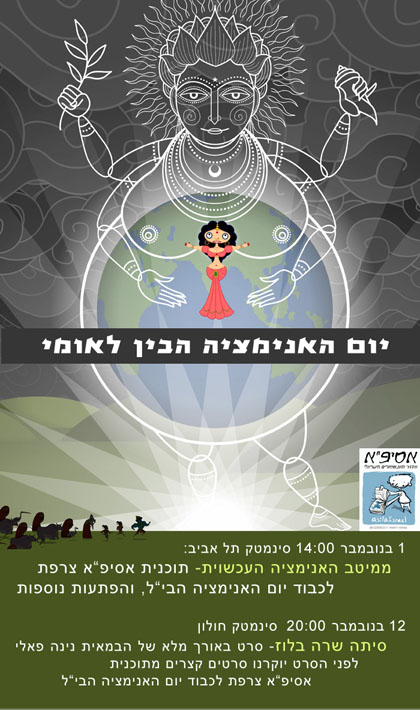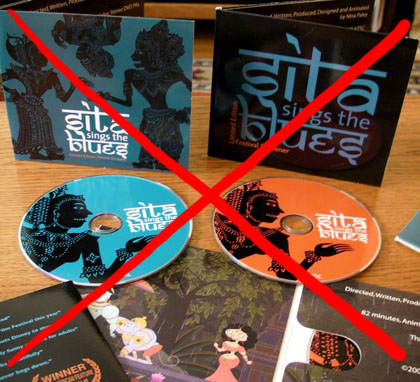I never learned Hebrew so I don’t know what that headline means – I just cut and pasted the name of the jpeg Gilat sent me. I do know Sita Sings the Blues will screen with Hebrew subtitles at Holon Cinimateq/Animateq on November 12 for Animation Day. I won’t be there (I’ll be in San Francisco) but my ASIFA-Israel friends will be. Tell your Hebrew-knowing friends!
Category: Publicity Bitch
Publicity Bitch sez: Awards!
It doesn’t come off as humble, but my alter-ego Publicity Bitch has some exciting awards news about Sita Sings the Blues.
First, from the the 37th Festival du Nouveau Cinéma in Montreal:
the prestigious Z Télé Grand Prize – prestigious because it is voted upon by those who actually buy tickets to films in the festival – went to Sita Sings the Blues, Nina Paley’s riotous animated musical appropriation of the Indian lit classic, Ramayana, billed as “the Greatest Break-Up Story Ever Told.” (link)
Thank you, Montreal!
Second, today IFP announced its nominees for the 2008 Gotham Awards:
Best Film Not Playing at a Theater Near Youâ„¢
Afterschool
Antonio Campos, director; Josh Mond, Sean Durkin, producers
Meadowlark
Taylor Greeson, producer/director
The New Year Parade
Tom Quinn, director; Steve Beal, Tom Quinn, producers
Sita Sings the Blues
Nina Paley, producer/director
Wellness
Jake Mahaffy, director; Jake Mahaffy, Jeff Clark, producers
Thanks, IFP!
And as always, big thanks to you friends, supporters, and viewers for helping my little film make its way in the world.
Meet Aseem Chhabra!
In addition to being a professional journalist, desi cultural maven, and all-around entertaining guy, Aseem was the voice of “Shadow Puppet #1” in Sita Sings the Blues. He’ll be representing the film at some upcoming Southern California screenings*:
Monday, Oct. 13, 8:30 pm
RedCat Cinema
631 W. 2nd St., Los Angeles CAThursday, October 16, 7:00pm
with sound designer Greg Sextro!
ArtPower at UC San Diego/The Loft
9500 Gilman Drive #0078, La Jolla, CA 92093
Have a great time, you crazy kids!
*which I’m sitting out due to illness
Best Script in Athens!
Sita Sings the Blues won Best Script at the Athens International Film Festival. It’s an honor I credit to Sita’s talented collaborators, especially Manish Acharya, Aseem Chhabra and Bhavana Nagulapally, who improvised all the narration.
Sita also received an Honorable Mention for “Best Animated Feature Film” at the Ottawa Animation Festival.
So the film is in excellent health, even while I am a quivering wreck.
“Review Copies”
Look what arrived today! Thanks to Gillian and Sylvie at Elektrofilm for the professional authoring in both PAL and NTSC formats that hopefully won’t crash like my home-authored version, and especially to my genius Momz for managing what turned into a more complicated logistical challenge than any of us imagined.
These aren’t for sale, of course – that would be illegal. They’re just festival screeners and review copies for, like, reviewing and screening in a festive manner.
Update: That said, it has some, ah, glitches. Glitches that apparently some people won’t notice, or think I did on purpose, but watching them feels like knives in my heart. Glitches which I must correct on the “next” version. Glitches which were in my HD master. Oh boy.
Sita in Livingston, New Jersey, this Saturday Sept. 6
Yep I’ll be there, along with the awesome and delectable Reena Shah, a Livingston native. This event was instigated by Anju Bhargava, who has written extensively on Sita:
Sita, more than any other character, is an integral part of the Indian woman’s psyche. At every stage of an Indian woman’s life, her name is invoked. Anju Bhargava found it amazing that one great epic written by a poet thousands of years ago has shaped and continues to shape and reshape the thinking of an entire culture. And, how certain aspects of a character have been emphasized more than others to suit the political and societal norms of the day. They have been understood or misunderstood to manage relationships through control and power. She has often wondered what the impact of Ramayan to the Indian culture would have been if it these characters had not been canonized. What if the popular cultural focus was not primarily on the Sita agni parikshay. What if the characters were understood as the flesh and blood characters that Valmiki was attempting to bring to life in his great poem! This reflection of Sita took her further along in her own quest of understanding Indian womanhood. In many respects she has come back full circle. She was ambivalent towards Sita, then rejected her, and now has come to accept her as an Indian cultural icon. She shares her understanding of Sita in her essay www.sitayanam.com .
This will be the first screening I attend equipped with the long-awaited “limited edition festival screener” DVDs, which of course I can’t legally sell, but I’ll have a box of ’em for all you “movie reviewers.” And of course you can legally donate to the artist, who is currently homeless, broke and in debt.




